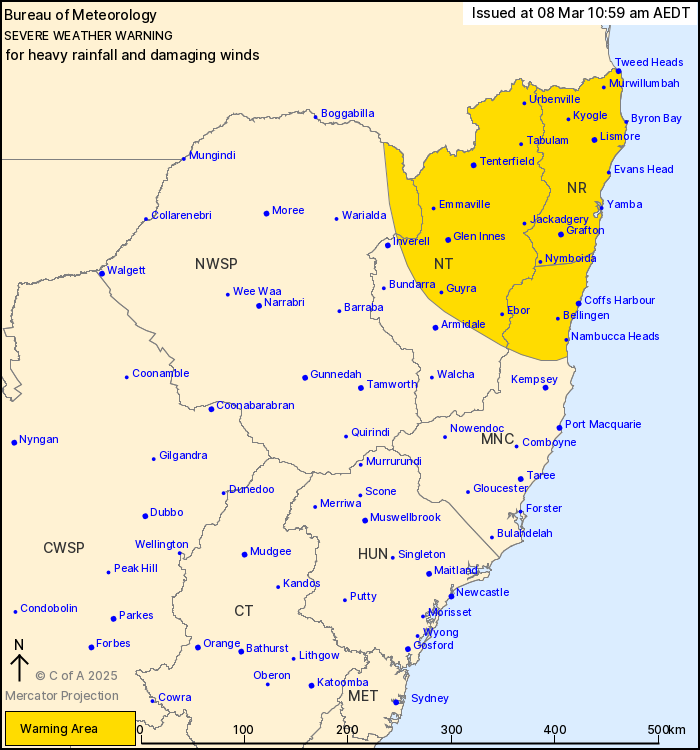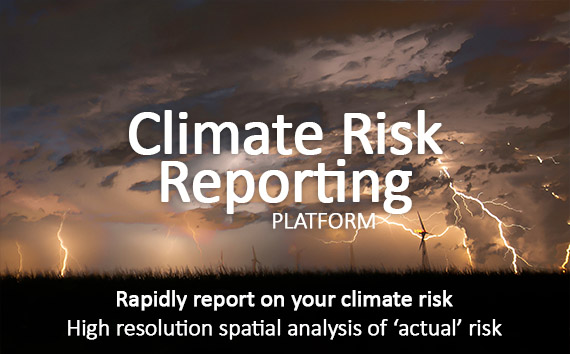Source: Bureau of Meteorology
For people in Northern Rivers, Northern Tablelands and parts of
Mid North Coast and North West Slopes and Plains Forecast
Districts.
Issued at 10:59 am Saturday, 8 March 2025.
Ex-Tropical Cyclone Alfred has weakened but heavy rainfall and
damaging wind gusts are still expected over northeastern NSW during
today and Sunday.
Weather Situation: Ex-Tropical Cyclone Alfred lies just off the
southeastern Queensland coast and is slow moving to the
west-northwest, it is expected to make landfall along the coastline
over the next several hours before moving inland and weakening
later today. Heavy rainfall and damaging wind gusts will extend
well to the south of the centre of the system over parts of the
Northern Rivers, Northern Tablelands and Mid North Coast.
HEAVY RAINFALL which may lead to FLASH FLOODING is possible today
about parts of the Northern Rivers, Mid North Coast and Northern
Tablelands, and is expected to increase through inland parts of the
warning area during Sunday. Six-hourly rainfall totals between 70
and 130 mm are likely, increasing to around 200 mm about the Border
Ranges. 24-hourly rainfall totals between 120 and 200 mm are
likely, increasing to between 200 to 250 mm about the Dorrigo
Range, and 200 and 300 mm about the Border Ranges. All rainfall
numbers are dependent on the movement and position of the
system.
DAMAGING WIND GUSTS with peak gusts of around 100 km/h are
possible today with showers and thunderstorms about the coastal
fringe north of Ballina, easing by Sunday morning. Damaging wind
gusts of around 90 km/h remain possible over parts of the Northern
Tablelands, becoming more likely overnight into Sunday morning
before easing by the early afternoon Sunday.
A Tropical Cyclone Forecast Track Map is current for Tropical
Cyclone Alfred.
A Coastal Hazard Warning and Hazardous Surf Warning is
current.
A Flood Watch and Flood Warnings are current for New South
Wales.
For these products, please refer to:
http://www.bom.gov.au/australia/warnings/
Locations which may be affected include Lismore, Grafton, Coffs
Harbour, Tenterfield, Yamba, Woolgoolga, Sawtell and Dorrigo.
The State Emergency Service advises that people should:
* Don't drive, ride or walk through flood water.
* Keep clear of creeks and storm drains.
* If you are trapped by flash flooding, seek refuge in the highest
available place and ring 000 if you need rescue.
* Be aware that run-off from rainfall in fire affected areas may
behave differently and be more rapid. It may also contain debris
such as ash, soil, trees and rocks.
* After bushfires, heavy rain and the loss of foliage can make the
ground soft and heavy, leading to a greater chance of
landslides.
* Move vehicles under cover or away from trees.
* Secure or put away loose items around your house, yard and
balcony.
* Keep at least 8 metres away from fallen power lines or objects
that may be energised, such as fences.
* Trees that have been damaged by fire are likely to be more
unstable and more likely to fall.
* Report fallen power lines to either Ausgrid (131 388), Endeavour
Energy (131 003), Essential Energy (132 080) or Evoenergy (131 093)
as shown on your power bill.
* Stay vigilant and monitor conditions. Note that the landscape
may have changed following bushfires.
* For emergency help in floods and storms, ring your local SES
Unit on 132 500.

08/Mar/2025 12:07 AM



